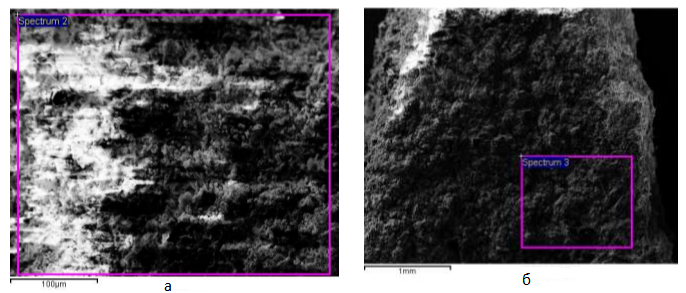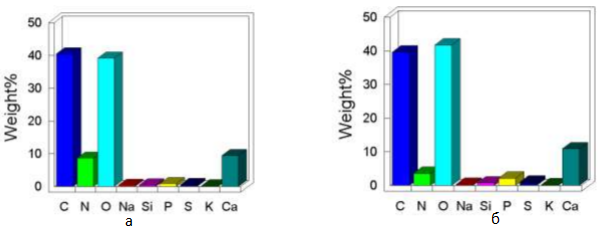Определение содержания биогенных элементов в жидких отходах животноводства
Определение содержания биогенных элементов в жидких отходах животноводства
Аннотация
Представлены результаты исследований содержания биогенных элементов в жидких отходах животноводства. Жидкие отходы, получаемые в результате интенсивного животноводства, оказывают негативное воздействие на окружающую среду. Соединения азота и фосфора в отходах свиноферм загрязняют почву и водоемы. Важно найти возможные способы селективного отделения всех ценных компонентов – главным образом азота, фосфора и калия (NPK) – из жидких отходов свиноферм, обеспечивая при этом безопасность получаемых продуктов для содействия использованию отходов в качестве вторичного сырья для получения качественных удобрений. В ходе работы были получены, в виде порошков, образцы исходного осадка свинофермы и осадка, обработанного коагулянтами. Количественный состав элементов определяли регистрацией интенсивности излучения с определенной энергией. При этом количество азота снижается с 8,59% до 3,57% за счет перехода его в жидкую фазу при разделении. Содержание калия и фосфора увеличивается, соответственно, с 0,13% до 0,23% и с 0,87% до 4,1%, как за счет образования солей, выпадающих в осадок, так и за счет дополнительного внесения этих элементов с реагентом (аммофос).
1. Introduction
In the modern world, new opportunities are opening up for fertilizer producers to obtain organic secondary raw materials, increasing interest in research on nutrient recovery technologies. Wastes are becoming a resource with appropriate management and treatment. Some studies have identified three main waste streams that could potentially be used to produce biologically based fertilizers: manure, sewage sludge, and food industry waste. There only liquid wastes from livestock represent the largest waste stream, and pig manure causes the greatest environmental concern about its safe disposal
. Liquid waste from pig farms often has a low stoichiometric ratio of N and P, therefore, using as fertilizers to meet the needs of the agricultural produce, phosphorus is often added to them, which increases the risk of its leakage into reservoirs. Phosphorus is a non-renewable source, and the bulk of the mineral reserves of phosphorus are found in several countries. In this context, phosphorus is included in the list of critically important raw materials . Liquid waste produced as a result of intensive animal farming has a negative impact on the environment. Nitrogen and phosphorus compounds in pig farm wastes pollute the soil and reservoirs. Stored liquid waste releases an odor, primarily due to the anaerobic decomposition of proteins. Pig farm waste is a mixture of feces, urine and water . In most countries, almost all of the resulting liquid waste from pig farms is returned untreated to agricultural fields by application, which can harm the environment due to the surplus of nutrients, an unbalanced supply of macronutrients and the presence of heavy metals and helminths. On that account it is utterly important to find possible ways of selective separation of all valuable components; mainly nitrogen, phosphorus and potassium (NPK), from pig farm liquid waste, whilst ensuring the safety of the products obtained to promote the use of waste as secondary raw materials to produce high-quality fertilizers that can compete with commercial ones. Both physical and chemical processes are used to extract nutrients from pig farm liquid waste. However, the high water content in pig farm liquid waste is one of the main obstacles to the efficient reuse of nutrients. When separating liquid waste from pig farms, a liquid phase rich in ammonium nitrogen (NH4 –N) and potassium (K) is formed, and a solid fraction rich in organic matter, phosphorus and relatively rich in nitrogen. The concentration of phosphorus and organic substances in the solid fraction enhances nutrient management and facilitates the export of excess nutrients to areas with their deficiency. After separation, the liquid fraction can be used as a more nutrient-balanced fertilizer in agricultural fields. The low total concentration of solids in the liquid fraction, comparing with the initial liquid waste of pig farms, reduces transportation costs associated with pumping manure and reduces NH3 emissions at the application phase, due to faster infiltration into the soil . Depending on different waste separation methods, the moisture distribution, organic matter and nutrient content between the solid and liquid fractions were widely varied. The choice of separation technology or combination of technologies depends on the characteristics of the initial manure and the manure management aims of the specific and particular site .The authors have proved the high efficiency of reagent coagulation for the separation of liquid waste from pig farms
. The aim was to study the dynamics of the biogenic element content in the sediment of pig farm liquid waste during reagent treatment using the lime suspension as an alkaline coagulant and ammophos as an acidifying reagent. To achieve this goal, the following tasks were solved: to determine the structure of the sediment, the qualitative and quantitative content of elements in the sediment by various methods (X-ray fluorescence spectroscopy and using an atomic adsorption spectrometer).2. Research methods and principles
The dynamics study was conducted at Platov South-Russian State Polytechnic University (NPI) in the period from 2022-2023. In the course of the study, samples of the initial pig farm sediment and the coagulants treated sediment were obtained in the form of powders. The samples were dried to constant humidity for more accurate analysis. The mass fraction of dry matter was determined in accordance with the requirements of GOST 26713-85 "Organic fertilizers. Method for determining moisture and dry residue" on the UNICO 2100 spectrophotometer . To determine the mass fraction of nutrients with initial moisture, an analysis was performed on an atomic adsorption spectrometer "Quantum-2mt" in agreement with GOST 26715-85, 26717-85, 26718-85
, , . X-ray spectral elemental analysis of the studied samples was determined using a scanning electron microscope Carl Zeiss EVO 40 (mode:Everhart-Thornley SE detector, EHT=20kV, WD=10mm, utilizing an additional Oxford "Inca Energy" system). The spectra were calibrated by the use of a reference metal sample (Co). The method is based on the collection and analysis of the spectrum obtained after excitation of the characteristic X-ray radiation that occurs during the transition of an atom from the excited to the unexcited state. When an atom is irradiated, electrons are removed from its inner shells. Electrons from the outer shells leap to vacant places, releasing excess energy in the quantum form or transferring it to another electron from the outer shells. In our case, X-ray radiation is used as an excitation source. Energy dispersive X-ray spectroscopy makes it possible to quickly determine the qualitative and quantitative elemental composition of solid and liquid samples, powders, granules, plates, films, not destroying the sample, which is important working with liquid waste sediments . By measuring the emission of atoms of the studied elements, it is possible to obtain the high-quality elemental composition. The quantitative composition of the elements was determined by recording the intensity of radiation with the defined energy. The measurements were conducted in three repetitions. The data was reflected on the tables and graphs, where each of the values seems an arithmetic mean. Statistical processing of the results was performed using the MS Excel program.3. Main results
To determine changes in the sediment structure as a result of reagent treatment of the initial and obtained waste samples. The samples were studied on the trial particle obtained as a result of natural cleavage without additional mechanical processing and application of a conductive metal layer. The particle had an elongated shape measuring 8x5 mm. The sediment structure is loose. In the absence of a conductive layer, as well as due to the clear relief of the samples in the figure (Fig.1 a,b), contrast differences are straightforwardly observed, indicating the presence of heterogeneous inclusions in the samples.

Figure 1 - Structure of sediment from liquid waste from pig farm during spectrometry of samples
Note: a – initial sediment from pig farm before treatment; b – waste sludge from pig farm after reagent coagulation

Figure 2 - Content of elements in samples
Note: a – initial sludge from pig farm before processing; b – waste sludge from pig farm after reagent coagulation
Table 1 - Results of studying samples using a scanning scanning electron microscope
Element content,% | initial sludge from pig farms before processing (dried) | sludge from pig farm waste after reagent coagulation (dried) | ||
Actual value | Measurement error (with confidence probability p=0.95) | Actual value | Measurement error (with confidence probability p=0.95) | |
C(carbon) | 40,41 | ±1,03 | 39,52 | ±0,98 |
N (nitrogen) | 8,59 | ±0,16 | 3,57 | ±0,10 |
O (oxygen) | 39,13 | ±2,05 | 41,68 | ±3,12 |
Na (natrium) | 0,37 | ±0,05 | 0,31 | ±0,05 |
Si (silicium) | 0,43 | ±0,02 | 0,78 | ±0,03 |
P(phosphorus) | 0,87 | ±0,05 | 4,10 | ±0,3 |
S(sulphuris) | 0,59 | ±0,01 | 1,02 | ±0,03 |
K(potassium) | 0,13 | ±0,02 | 0,23 | ±0,03 |
Ca (calcium) | 9,48 | ±0,1 | 10,91 | ±0,0 |
The samples contain phosphates of calcium bases, as well as traces of sodium-potassium salts. Silicon is contained in small amounts. The presence of carbon is associated with the organic origin of the studied samples. As a result of reagent treatment, an increase in the phosphorus and potassium content in the test sample (Fig. 2b) is observed. The decrease in the nitrogen content in the sample after processing and separation was noted, connected with the transition of its main part to the liquid phase. The presence of biogenic elements in the sediment of pig farm waste indicates their high potential for the use as the organomineral fertilizer.
Table 2 - Results of studying samples using an atomic adsorption spectrometer
The name of indicators | Samples studied | |||
original sludge from a pig farm before processing (dried) | pig farm waste sludge after reagent coagulation (dried) | |||
Actual value | Measurement error (with confidence probability p=0.95) | Actual value | Measurement error (with confidence probability p=0.95) | |
Mass fraction of dry matter, % | 90,85 | ±0,41 | 92,99 | ±0,41 |
Mass fraction of nutrients in samples with initial humidity,% | – | |||
Total nitrogen | 8,2 | ±0,1 | 3,34 | ±0,2 |
Total phosphorus, calculated as P2O5 | 0,7 | ±0,05 | 4,05 | ±0,2 |
Total potassium, expressed as K2O | 0,14 | ±0,01 | 0,22 | ±0,03 |
Studies of the content of biogenic element dynamics in the sludge of pig farm liquid waste during reagent treatment in two different ways showed the high precision of results (about 80%).
4. Conclusion
The figures obtained using a scanning electron microscope Carl Zeiss EVO 40 indicate the compaction of the sediment structure under the action of reagents (the process of rapid coagulation of particles, leading to in the sedimentation rate, which leads in turn to the decrease in the structures of the volume sediment). Thus, as a result of the coagulation treatment of liquid waste, it is possible to reduce the cost of capital construction of settling tanks.
As a result of reagent treatment of pig farm liquid waste sludge, the dynamics of the content of such biogenic elements as nitrogen, phosphorus and potassium was observed. At the same time, the amount of nitrogen is significantly reduced due to its transition to the liquid phase during separation. The formation of salts precipitating and the extra addition of the elements with the reagent (ammophos) both due to the content of potassium and phosphorus increases. The presence of biogenic elements in the sediment of pig farm waste indicates their high potential for the use as the organomineral fertilizer.
